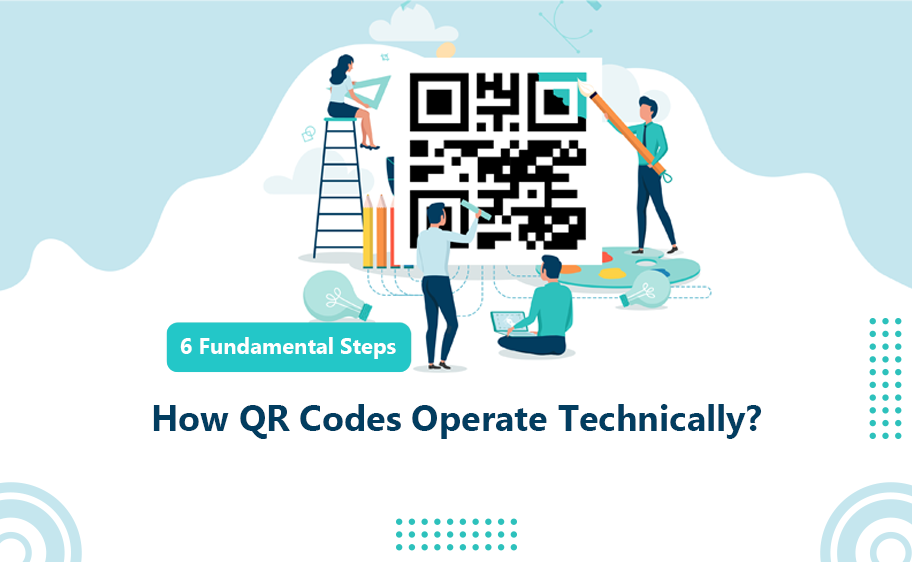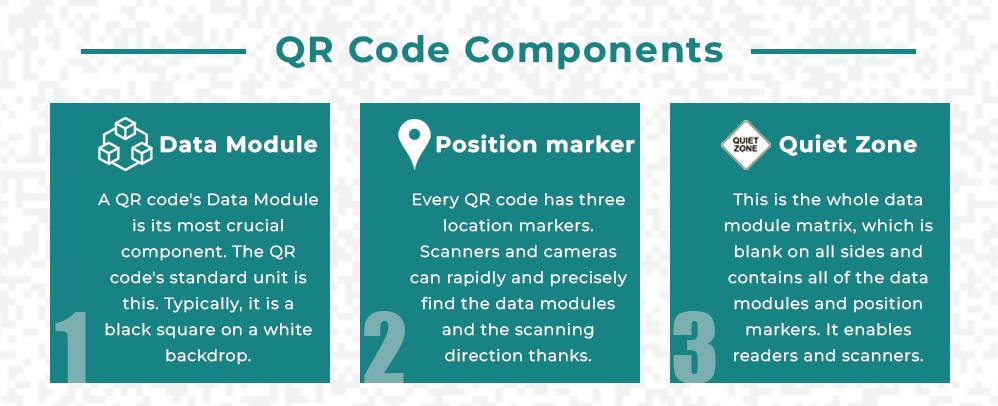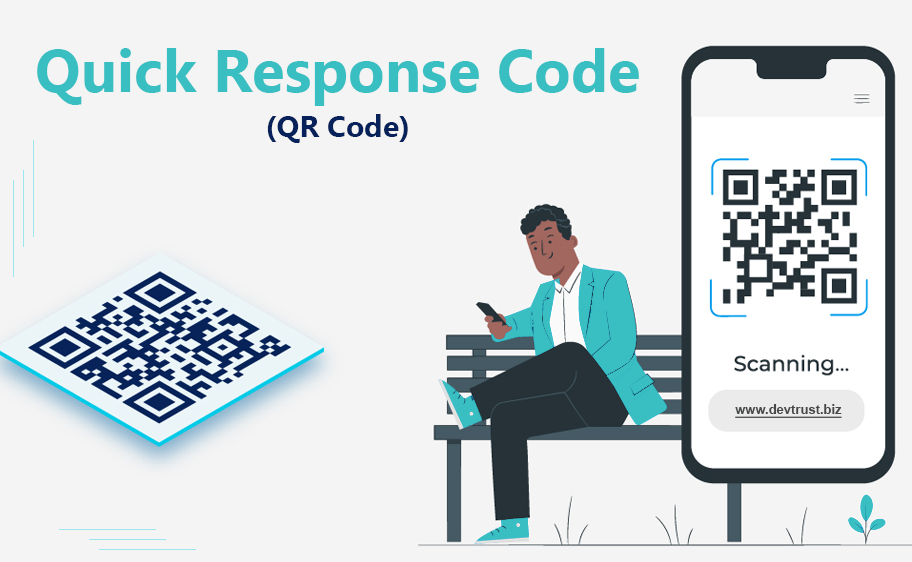What exactly is a QR code?
It is a barcode known as a QR code. You may retrieve the data embedded in it by scanning it.
The data is encoded in the width and spacing between vertical lines in traditional barcodes. It encodes information in the configuration of squares in QR codes. In either case, data is transformed into a combination of visible pieces that is machine-readable. Additionally, the data transform back into its original form after being scanned by optical scanning equipment.
But three factors make QR codes particularly unique. The amount of information they can hold, how rapidly they can be scanned, and the ease with which almost all of our phones can do so.

How Do QR Codes Operate?
A data-encoded machine-readable barcode is known as a QR code. To be encoded is to change into a certain format. When it comes to QR codes, numeric, alphanumeric, byte and kanji characters translate into a distinctive two-dimensional arrangement of squares. After passing over those squares, an optical scanner converts their arrangement back into the original data format.
Here is one instance. For the hospitality industry, we generate unique, digital restaurant table menus based on QR codes. We have a sample digital menu that we can present to prospective parties because of this. We encoded the URL of the example menu into the QR code below to demonstrate what we can achieve.
Here is how these little marvels function
The positioning of the squares, or data modules as they are known in the QR code, is really our URL. The URL’s alphanumeric sequence has just been converted into a matrix of squares. That is how a link becomes a QR code. The original URL will then be shown when a QR code is scanned.
QR Code Components
Most people considering making a QR code should be interested in the anatomy of a QR code. But be mindful of the security risks that free internet services using QR codes pose.
QR codes consist of the following parts:
Data Module
A QR code’s Data Module is its most crucial component. The QR code’s standard unit is this. Typically, it is a black square on a white backdrop. It is recommended to make a QR code using black on white, even if the colours and contrast vary. The majority of a QR code is made up of how these black squares, or data modules, are arranged.
Position marker
Every QR code has three location markers. Scanners and cameras can rapidly and precisely find the data modules and the scanning direction thanks to their inner and outside eyes.
Quiet Zone
This is the whole data module matrix, which is blank on all sides and contains all of the data modules and position markers. It enables readers and scanners to visually locate the beginning and finish of the QR code.
Although they aren’t strictly required to understand if you’re studying how to create a QR code, being familiar with them is beneficial. These QR code components and the QR code’s scannability may be impacted by decisions made during its development.

QR Codes: What Data Can They Hold?
Size, error correction level, and data type are the three categories of data that a QR code stores.
Size
A QR code may contain up to 177 rows and 177 columns, resulting in a total of 31,329 potential data units. However, most QR codes aren’t that large.
A QR code’s size and version are related. Version 1 of the QR code has a maximum size of 21 rows by 21 columns. Version 2 is 25×25, and so on. Version 40 is the biggest QR code that is currently supported, measuring 177×177.
It’s important to remember that the minimum size of a QR code is often determined by scan distance rather than data size.
Levels of Error Correction
One of the four QR code error correction levels is encoded in a QR code. A QR code may absorb greater damage while still being scanned the higher the correction level. It resembles a QR code backup that has been saved. There is always greater room for size and data when the correction level is lower.
Data Type
Up to 2,953 alphanumeric characters or 7,089 numeric characters can be stored in a QR code. Although kanji and bytes can also be stored, they are less usually employed. The lowest level of error correction is assumed in these statistics.
This effectively implies that anything that communicates using letters, numbers, punctuation, or symbols may utilise a QR code. Business cards, QR codes on restaurant tables, authentication, hotel reservations, internet logins, contactless payments, digital wine lists, culinary uses of QR codes, and more.
For perspective, a typical one-dimensional barcode may carry somewhere between 20 and 100 characters. QR codes are far more valuable tools than traditional barcodes since they can hold such a vast quantity of data and deliver it rapidly. almost in every business.
But a QR code has to be bigger and more complex the more characters it stores, right? No, and yes. The distinction between static and dynamic QR codes is that.
The Function of Dynamic QR Codes
A dynamic QR code is one that may have its encoded information modified after it has been created. This would be due to the fact that a dynamic QR code’s information is simply a brief URL redirect. That refers to a URL that leads traffic to another URL, often known as a destination URL.
The content is located on the target URL. This might be an invitation, a curriculum, a computerised wine list, or other information. Without altering the QR code, that material may be completely modified. In addition, the QR code may be modified totally without changing the destination URL. Because the redirect URL, not the destination URL, is encoded in the QR code.
This configuration also makes it possible to dynamically track QR code scanning and usage, which is essential for any kind of QR code marketing.
One of the decisions a company must make when designing a QR code is whether to use a dynamic or static QR code. Many people also have questions about how dynamic QR codes operate considering their advantages. They are extremely amazing, therefore it is a valid question. They are also rather straightforward.
How QR Codes Operate Technically
You may find it simple to learn how to scan a QR code, but the scanner and QR code are working a little harder than you are.
The bottom right corner of the QR code is where the scanner starts. Then, until it reaches the first position marker, it advances two data modules at a time. Then it descends and shifts two data modules to the left. Until every data module is covered, it continues moving in a zigzag pattern from right to left and then up then down.
The fundamental six-step flowchart of the scanning procedure is shown below.
- Scan the QR code with your phone.
- The three-position markers in the QR code are recognised by the QR code reader in your phone’s camera. Your scanner is now aware of where the edges of the QR code are in a sufficiently calm region.
- The mode indication is encountered by the scanner as it starts at the bottom right. These four data modules specify whether the remaining encoded data is numeric, alphanumeric, byte, or kanji-based.
- The character count indication is the next set of 8 data modules the scanner encounters after the mode indicator. These give the total number of characters in the encoded material.
- The scanner then keeps moving in a zigzag pattern along the data modules after determining the data type and character length until it recovers all the encoded data and reaches the end indicator.
- The scanner continues along its journey to the mistake-correcting data modules after reading the last character. One of the four layers of error correction can be found inside these encoded modules. or how much of the encrypted data stored in a QR code is backed up in case the code is damaged.
You should now be able to see how a QR code functions.
That is how QR codes respond
Although we haven’t addressed all of the complexities of QR code encoding, this is a general idea.
An improvement over traditional UPC barcodes is the use of QR codes. Look at the history of QR codes. It’s because their encoding and scanning technology makes it possible to store considerably bigger data sets, scan documents more quickly, and alter documents after they’ve been created. They are a fantastic alternative for pubs and restaurants because of this. Regardless matter whether those companies choose to produce a QR code PDF menu or a completely responsive HTML menu. Just bear in mind that you’ll be in charge of the PDF accessibility if you design a menu in PDF format.

